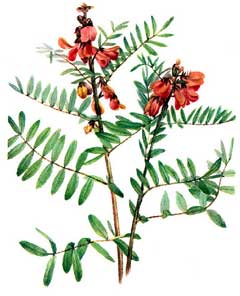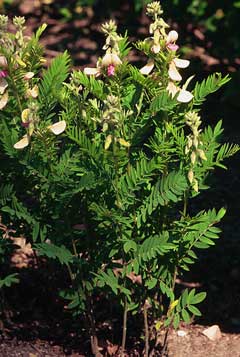 |
|
http://commons.wikimedia.org/wiki/File:Tephrosia_virginiana,_by_Mary_Vaux_Walcott.jpg |
 |
| www.forestryimages.org |
Translate this page:
Summary
Physical Characteristics

 Tephrosia virginiana is a PERENNIAL growing to 0.6 m (2ft).
Tephrosia virginiana is a PERENNIAL growing to 0.6 m (2ft).
See above for USDA hardiness. It is hardy to UK zone 4. It is in flower from May to July. The species is hermaphrodite (has both male and female organs) and is pollinated by Insects.
Suitable for: light (sandy), medium (loamy) and heavy (clay) soils, prefers well-drained soil and can grow in nutritionally poor soil. Suitable pH: mildly acid, neutral and basic (mildly alkaline) soils. It cannot grow in the shade. It prefers dry or moist soil and can tolerate drought.
UK Hardiness Map
US Hardiness Map
Synonyms
Plant Habitats
Woodland Garden Sunny Edge;
Edible Uses
References More on Edible Uses
Medicinal Uses
Plants For A Future can not take any responsibility for any adverse effects from the use of plants. Always seek advice from a professional before using a plant medicinally.
Anthelmintic Cancer Diaphoretic Diuretic Pectoral Tonic Women's complaints
The root is anthelmintic, diaphoretic, diuretic, pectoral and tonic[207, 222, 257]. A tea made from the roots is said to make children muscular and strong[222, 257]. A cold tea is used to improve male potency and also to treat TB, bladder problems, coughs, irregular menstruation and other women's complaints[222, 257]. Experimentally, the root has shown both anticancer and cancer-causing activity[222]. The leaves have been placed in the shoes in order to treat fevers and rheumatism[257].
References More on Medicinal Uses
The Bookshop: Edible Plant Books
Our Latest books on Perennial Plants For Food Forests and Permaculture Gardens in paperback or digital formats.

Edible Tropical Plants
Food Forest Plants for Hotter Conditions: 250+ Plants For Tropical Food Forests & Permaculture Gardens.
More

Edible Temperate Plants
Plants for Your Food Forest: 500 Plants for Temperate Food Forests & Permaculture Gardens.
More

More Books
PFAF have eight books available in paperback and digital formats. Browse the shop for more information.
Shop Now
Other Uses
Hair Insecticide
The root is a source of the insecticide 'rotenone'[207, 213]. This is especially effective against flying insects but appears to be relatively harmless to animals[213]. A decoction of the roots has been used as a hair shampoo by women in order to prevent hair loss[257].
Special Uses
Carbon Farming
References More on Other Uses
Cultivation details
Industrial Crop: Pesticide Management: Hay Wild Crop
A deep rooted plant, requiring a dry to moist light or medium very well-drained soil in a sunny position[200]. Plants are hardy to about -25° when given a suitable position[200]. This species has a symbiotic relationship with certain soil bacteria, these bacteria form nodules on the roots and fix atmospheric nitrogen. Some of this nitrogen is utilized by the growing plant but some can also be used by other plants growing nearby[200].
Carbon Farming
-
Industrial Crop: Pesticide
Many plants provide natural pesticides.
-
Management: Hay
Cut to the ground and harvested annually. Non-destructive management systems maintaining the soil organic carbon.
-
Wild Crop
Some wild plants have strong historical or contemporary use. Although they are not cultivated crops, they may be wild-managed.
References Carbon Farming Information and Carbon Sequestration Information
Temperature Converter
Type a value in the Celsius field to convert the value to Fahrenheit:
Fahrenheit:
The PFAF Bookshop
Plants For A Future have a number of books available in paperback and digital form. Book titles include Edible Plants, Edible Perennials, Edible Trees,Edible Shrubs, Woodland Gardening, and Temperate Food Forest Plants. Our new book is Food Forest Plants For Hotter Conditions (Tropical and Sub-Tropical).
Shop Now
Plant Propagation
Pre-soak the seed for 12 hours in warm water and then sow in a greenhouse in spring. Prick out the seedlings into individual pots when they are large enough to handle and grow on in the greenhouse for their first winter, planting out in the following spring or early summer.
Other Names
If available other names are mentioned here
Native Range
NORTHERN AMERICA: Canada (Ontario (south)), United States (Massachusetts, Michigan, New Hampshire, New York, Pennsylvania, West Virginia, Illinois, Iowa, Kansas, Missouri, Oklahoma, Wisconsin, Alabama, Arkansas, Florida, Georgia, Maryland, North Carolina, South Carolina, Virginia, Texas)
Weed Potential
Right plant wrong place. We are currently updating this section.
Please note that a plant may be invasive in one area but may not in your area so it's worth checking.
Conservation Status
IUCN Red List of Threatened Plants Status :

Growth: S = slow M = medium F = fast. Soil: L = light (sandy) M = medium H = heavy (clay). pH: A = acid N = neutral B = basic (alkaline). Shade: F = full shade S = semi-shade N = no shade. Moisture: D = dry M = Moist We = wet Wa = water.
Now available:
Food Forest Plants for Mediterranean Conditions
350+ Perennial Plants For Mediterranean and Drier Food Forests and Permaculture Gardens.
[Paperback and eBook]
This is the third in Plants For A Future's series of plant guides for food forests tailored to
specific climate zones. Following volumes on temperate and tropical ecosystems, this book focuses
on species suited to Mediterranean conditions—regions with hot, dry summers and cool, wet winters,
often facing the added challenge of climate change.
Read More
Expert comment
Author
(L.)Pers.
Botanical References
43200274
Links / References
For a list of references used on this page please go here
Readers comment
| Add a comment |
|
If you have important information about this plant that may help other users please add a comment or link below. Only comments or links that are felt to be directly relevant to a plant will be included. If you think a comment/link or information contained on this page is inaccurate or misleading we would welcome your feedback at [email protected]. If you have questions about a plant please use the Forum on this website as we do not have the resources to answer questions ourselves.
* Please note: the comments by website users are not necessarily those held by PFAF and may give misleading or inaccurate information.
To leave a comment please Register or login here All comments need to be approved so will not appear immediately.
|
Subject : Tephrosia virginiana
|
|
|
|